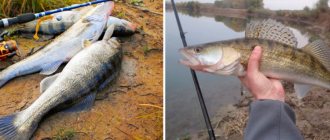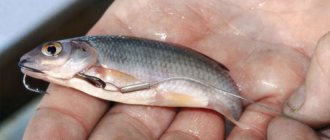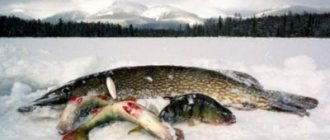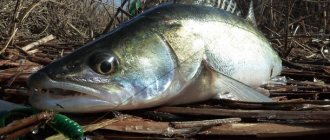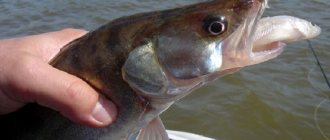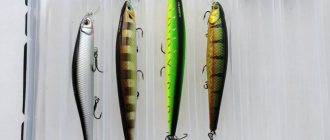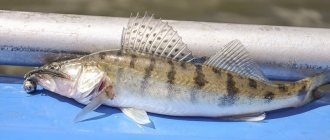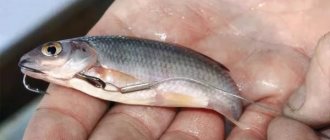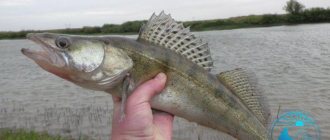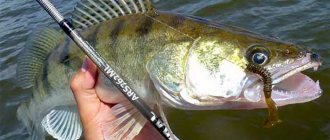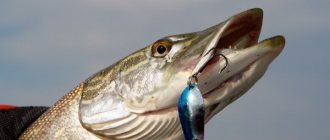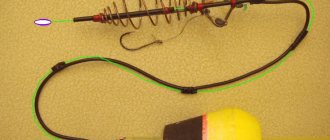Introduction
An ancient fishing tackle is the seine. Our ancestors successfully caught various fish using this unusual device.
Thanks to the shift, a good catch can be obtained both in areas with standing water and on rivers. Sea lure generally refers to fishing gear, so ordinary fishing enthusiasts will not find this type useful.
Depending on the equipment of the net, you can catch both peaceful species of fish and predatory representatives of the ichthyofauna.
To use this old gear with maximum benefit, you need to understand the principle of its operation and choose the optimal equipment option.
Let's look at how to make a sequin with your own hands.
Catfish. Bottom tackle with an underwater float for catching catfish (TEST 60kg). Fishing for catfish and pike
1 000.00 ₽
Classic bottom tackle
for catching catfish it is a tackle with a load of about 300-500 grams, with a powerful main cord and one or two leashes. Donka is brought in by boat; large live bait weighing 300–400 grams, frog, offal, etc. can be used as bait.
For catching catfish
It is necessary to use materials with a breaking load of at least 50 kg. The catchability of the gear greatly increases if the bait is lifted from the bottom, which is achieved using a system of underwater floats.
When using live bait, the float constantly pulls it upward, thereby preventing it from hiding at the bottom and at the same time forcing it to actively move. Floats can be placed either on the main cord or directly on the leash; the size and number of floats depends on the fishing conditions, the strength of the current, the depth of the reservoir, and the size of the bait.
Modern fishing tackle
, used for fishing mainly for
catfish
, as well as pike, is an installation in the form of a durable leader material with a diameter of 1.3 mm and a length of 2 m, at one end of which powerful hooks are tied, the main one is single and the safety hook is double, and at the other end there is a power carabiner.
All knotted and knotless connections are neatly sealed with silicone casings. An underwater float is installed 15cm from the hooks, which serves to ensure that the nozzle is above the bottom. Depending on the size and weight of the bait, the number of floats can be increased or decreased.
The float should not slide, and is secured using a system of stoppers made of beads and a clasp. Especially on reservoirs with a current, this type of donk has many advantages.
When using worms, dead fish, or a long strip of fish, the bait will play attractively in the current, while spreading the scent much more effectively than bait lying on the bottom.
Catfish. Bottom tackle with an underwater float for catching catfish
3mm, length 200cm, breaking load 135kg (color yellow or light brown) Single hook
— 1 pc Owner No. 9/0
Double hook
— 1 pc Owner No. 5/0
Underwater float
— 1 pc impact-resistant, low deformation, with a displacement of 200 g
Inserts for the float
— 2 pcs made of dense wood coated with varnish.
Restrictive plastic beads
- 2 pcs
Float stopper
- 2 pcs
Power carabiner
- 1 pc Owner breaking load 60 kg
Silicone cambric 5mm*4mm
- 15cm
Silicone cambric 5mm*4mm
- 5cm
Silicone cambric 5mm*4mm
- 4cm
Silicone cambric 4mm*3mm
- 3cm
Bead with swivel and carbine
— 1 pc.
Instructions
— 1 pc.
Packaging
— 1 pc.
Rice. Diagram of catfish gear with an underwater float
Catfish
fully equipped and ready to use, float is removable
Classic bottom tackle
for catching catfish it is a tackle with a load of about 300-500 grams, with a powerful main cord and one or two leashes. Donka is brought in by boat; large live bait weighing 300–400 grams, frog, offal, etc. can be used as bait.
For catching catfish
It is necessary to use materials with a breaking load of at least 50 kg. The catchability of the gear greatly increases if the bait is lifted from the bottom, which is achieved using a system of underwater floats.
When using live bait, the float constantly pulls it upward, thereby preventing it from hiding at the bottom and at the same time forcing it to actively move. Floats can be placed either on the main cord or directly on the leash; the size and number of floats depends on the fishing conditions, the strength of the current, the depth of the reservoir, and the size of the bait.
Modern fishing tackle
, used for fishing mainly for
catfish
, as well as pike, is an installation in the form of a durable leader material with a diameter of 1.3 mm and a length of 2 m, at one end of which powerful hooks are tied, the main one is single and the safety hook is double, and at the other end there is a power carabiner.
All knotted and knotless connections are neatly sealed with silicone casings. An underwater float is installed 15cm from the hooks, which serves to ensure that the nozzle is above the bottom. Depending on the size and weight of the bait, the number of floats can be increased or decreased.
The float should not slide, and is secured using a system of stoppers made of beads and a clasp. Especially on reservoirs with a current, this type of donk has many advantages.
When using worms, dead fish, or a long strip of fish, the bait will play attractively in the current, while spreading the scent much more effectively than bait lying on the bottom. By connecting the end of the main cord with a weight of 300-500 grams and attaching a catfish to the cord (the distance to the bottom weight should be approximately half the depth of the reservoir), you can attach the bait, bring the tackle on the boat and start fishing.
Tackle design
This tackle was appreciated by our grandfathers for its simplicity of design.
The net is based on a long cord or thick fishing line. Its ends were usually tied to stakes driven into the bottom. Leashes with hooks were attached to the base. Their quantity is limited to 5-10 pieces.
A loop system was used to connect the leads to the main line. This has its advantages. Thanks to this installation, it was possible to store leashes with hooks separately from the saddle. Today, you can attach them to the cord using swivels and carabiners.
To avoid overlapping of leashes, it is necessary to strictly maintain the distance between them. Calculating the optimal length is easy. The size should be 1-2 cm less than half the length between adjacent leashes.
If the hooks are not removed from the tackle during transportation, then the tip of each of them is hidden in pieces of cork. Some experienced anglers make a reel out of foam. In this case, you can wind the hooked webbing and hide the sting in foam plastic.
Tips for choosing
You can catch catfish from a boat in the fall on the Don, in Astrakhan, and in another region. In order for your fishing to be successful, it is recommended to follow the advice of professionals.
Go hunting at night, in the evening, early in the morning
The predator can be found not far from the shore, since it is here, under the dark cover, that it looks for prey in the form of frogs, crayfish, and shells.
During the day, the ideal place for catching catfish is the average depth of the reservoir, as well as the washed-out shore.
A slow-moving water source involves casting bait above the current level from where the fish may be.
When choosing bait for this huge predator, you should pay attention to the attractiveness of its aroma, and not to the color. The catfish is an almost blind representative of the fauna.
When going fishing, you should take several types of baits with you.
When hunting for catfish, it is necessary to periodically check the quality of the bait on the hook.
With a good knowledge of the features of the bottom of the reservoir, a fisherman can count on a high catch.
You need to feed the predator with the same products that are attached to the hook.
Before going fishing, you need to carefully check the strength of the equipment, as well as the absence of knots on it.
When fishing for catfish, a hunter should not forget about safety rules.
- You should not wrap the fishing line around your hand, as you can get seriously injured when biting.
- If you take a catfish under the lower jaw, it can dislocate a human arm. For this reason, the predator should initially be stunned and then dragged into the boat.
- If the prey weighs 70 kilograms or more, it must be towed to shore without being pulled out of the reservoir.
When choosing gear for catfish, you should give preference to the strongest and highest quality.
Rod. The stronger this fishing attribute, the better for the fishing process.
Reel and line. The reel should be as durable as possible; in this case, a multiplier model may be the best option. Each fisherman will have to decide whether to give preference to monofilament or braid according to his individual preferences.
Weight, leash, hook. The choice of weight of the weight is directly influenced by the nature of the bait and the fishing area. If the line is thick, then the weight should be heavy. It is better to make leashes from monofilament fishing line, its length should be 1 meter
When selecting a hook, you should pay attention to the barb. Its protrusion to the side will make hook penetration difficult.
Regardless of the size of the caught predator, such fishing will be filled with numerous emotions and impressions. Despite a lot of troubles that a fisherman will have in the process of preparing for such an event, there is no need to deny himself such pleasure.
Types and varieties of strait
There are many different designs of saddles, which can be divided into several categories depending on the horizon of the bait.
- Bottom nets are designed for catching fish species that prefer to lead a bottom-dwelling lifestyle and feed. These include crucian carp, tench, carp, carp, pike perch, burbot, catfish, etc.
- Straps, the hooks of which are located in the middle layers of the water area , are better suited for catching sabrefish, rudd, pike, perch, and ide. To hold the leashes in the water column, floats or buoys are used, which are attached to the cord.
- Riding bars are usually stretched over the surface of the water area. The hooks are equipped with insects, behind which fish species such as chub, asp, and trout rise.
Types of saddles
There are several types of correct transition:
- Horse. An effective specimen for catching fish grouped in the upper water layers (almost at the surface). Such representatives include trout, chub and other small fish. Such equipment is positioned so that the main cord is above the mirror surface along with the leashes on which the bait is hooked.
- Medium (its second name is longitudinal). Used for fishing for individuals living under the water column (perch, pike). The design additionally includes foam floats attached to the cord - they prevent the gear from sinking.
- Donny. Tackle designed for deep fishing at the very bottom, regardless of the presence or absence of current. Using this tool you can catch carp, catfish, burbot, and pike perch.
Trap fishing tactics
Before you go fishing, you need to choose the most suitable saddle design for the types of fish that are active at the time.
The characteristics of the reservoir should also be taken into account. For example, if the river is wide enough, it is unlikely that it will be possible to install the tackle across the current.
An important point when preparing for cross-country hunting is the choice of bait. If predators come under the angler's sights, then the best bait for fishing will be a live fish. Its size is determined by the type and size of the expected prey. So, to catch perch you need a small gudgeon or roach.
To see a large catfish bite, you will have to catch bait weighing more than 1 kg. When you have to catch a predator in a snag, it is better to hook a dead fish. Then the tackle will not get tangled in underwater obstacles.
In addition, it is important to securely strengthen the tackle so that a large fish caught on the hook cannot drag it into the reservoir. By the way, a driftwood floating by can move a fringe on a river.
When, where and how to catch?
You can catch catfish using a line at any time of the year. But in winter only when the reservoir is not covered with ice. After all, the presence of such an obstacle makes fishing with a line impossible.
There is no specific fishing spot for catfish; any hole, spit or riffle is suitable. After all, catfish can swim anywhere, as they swim out at night in search of food.
You can set a line both in rivers and on lakes. For each type of reservoir there is a different installation method. For rivers you need to place it in the middle of the current, and in closed reservoirs - not far from the shore, where the fish are often fed.
You need to carefully choose the installation location, because if there are snags at the bottom, the net may get caught, and this will lead to loss of gear.
For bait, you can use live bait, such as crucian carp, burbot, bindweed or other types of fish that have high endurance. You can also use chicken or fish offal. A fish like catfish will not refuse frogs (especially river ones), crayfish or red worms.
Catfish are often caught using leeches or mole crickets, because they stay on the hook for a very long time.
- You should never skimp on the quality of your gear, because if it is made correctly, it will last for many years.
- When you need to swim to check the tackle, be sure to take a landing net with you.
- When you come across very large specimens, it is best to wait a while until the fish gets tired, and then place it in a net.
- To make the leashes more reliable, it is better to make them from rawhide.
- You need to install the crossbar very carefully and mask it very carefully. This is necessary so that in the morning you don’t have to be upset if the tackle is lost.
A group of fishermen revealed the name of the secret bait during interrogation.
Category: Regional news,
40 kg of fish for bait with pheromones. Report 2021!
The catchable bait ingredient will be banned from sale.
2013-2017. Sports fishing knowledge base Primanki.com © All rights reserved.
Illegal copying of materials from our site without mentioning the source link is prohibited.
, . Detained poachers told the secret of catching 318 kg of fish. Fishing inspectors were surprised by the absence of prohibited equipment.
Installation methods
Beginner fishermen make some mistakes when installing a line. The result of these incorrect actions is a lack of bite or loss of gear.
There are several proven methods for installing a saddle:
- With this method, one end of the tackle is first secured to the shore. To do this, a peg is driven into the ground, and a fishing line is rigidly fixed to it. Then the angler must swim into the water at a distance that allows him to overcome the length of the line. After this, a long stake is installed at the selected point. The connection of the other end of the strap can be rigid or elastic.
- In the second option, it is necessary to equip the net with a shock-absorbing cord 1-2 m long. Such tackle can be re-thrown without completely removing the net from the water.
- To catch bottom species of fish , for example, burbot, instead of a long stick, which is installed at depth, a heavy load is used. It could be a stone, brick or metal object. Additional weights are attached between the leashes on the main line, which are most easily made from sheet lead. A peg is also driven in near the shore and one end of the tackle is tied. Heavy loads can be thrown from the shore or lowered using a boat.
- The line can be installed so that the leads are in the water column. This method involves adjusting the position of the bait. This is easily done by changing the length of the ropes that connect the main line of the line with the buoys. First, the tackle is attached at one end to a peg or heavy weight. Then the buoys are installed and the fishing depth is adjusted. When the tackle is placed in the desired area, the second end is rigidly fixed.
- Horse casting is usually used on narrow bodies of water. The length of the main line should be enough to secure it on opposite banks. The middle of the beam may sag, so you should tie a foam float with a mast to the base. Such a simple device will hold the tackle above the surface of the water.
How to install
Options for installing a stile depend on its type and characteristics of the reservoir. The main thing is that the tackle has a reliable flotation device. Otherwise, the hooks will become entangled with each other, and the fish will not even notice the bait.
The classic way to install a fishing line is to stretch it between two stakes driven into the bottom of the reservoir. One end of the rig is tied, the other (the catcher) is stretched to the required length and fixed to the second peg. Then floats are installed so that the tackle is held in the desired water area and is not carried away by the current. After balancing, they begin to place the bait on the hooks. In this manner, the bottom and middle crossbars are installed.
In addition to the classical method, fishermen often resort to setting up bottom or medium gear by fastening one part on the shore, and the other directly in the reservoir. Surface tackle is usually used in shallow water. The stakes are driven into the ground and the equipment is tied to them by the ends. Instead of pegs, you can use two trees on opposite banks, located at a sufficient distance from each other (if the river is not very wide).
Crossing on the river
A few more options for installing the crossbar:
- Two people stand on opposite banks of the river and hold a rod and reel in their hands. It is important to initially agree on who is responsible for reeling in the fishing line and who will release it. The design of the gear is primitive: the required number of leashes are tied in the middle at a distance of 1 meter. Each is 60 cm long and 0.4 in diameter, with the thickness of the main cord being 0.6.
- One end of the net is attached to a stake on the shore, the other is fixed at the bottom of the reservoir with a heavy stone. Along the entire length of the base line, weights are placed between the leashes so that the tackle falls down. This method is suitable for hunting burbot.
If a fisherman leaves equipment installed in the water all night, it is advisable not to leave it unattended. Otherwise, if there is insufficient camouflage, someone may covet the prey.
Choosing bait for casting
Different types of fish require baits that suit their lifestyle and the season.
- You can catch large predators (pike, asp, burbot, pike perch) only with the help of live bait. The best fry are considered to be: bleak, roach, gudgeon, crucian carp, small perch, ruff, and goby.
- For targeted hunting for catfish, special baits are required. These include: large live bait, frogs, chicken offal, crayfish, shells, a bunch of worms.
- Peaceful fish can be caught using baits such as corn, pearl barley, worms, peas, foam balls, insect larvae, insects.
- It is preferable to catch vegetarian representatives of freshwater ichthyofauna (grass carp, silver carp) with green plant bait. A 10 cm long piece of the core of a young shoot of cattail or reed is attached to the hook.
What baits are used
There are many different baits and lures for catching. If you plan to catch predators, it is recommended to use bait of animal origin. For peaceful individuals, plant and animal baits (barley, buckwheat, dough, corn, earthworms), as well as artificial lures (simulators of furry insects) are suitable. Killed live bait is ideal for snag areas. Pike, pike perch and asp love to eat roach, bleak, crucian carp, and minnows. The catfish prefers loach or spined loach, frogs, black leeches, and is not indifferent to beef liver and chicken offal. Individuals that take food from the surface should be treated with grasshoppers, stringworms, and the May beetle.
Fry caught from the surface can be used as bait
What is peremet
Predators were caught using a line back in ancient times; nowadays this tackle is known only to a select few. It is classified as a passive type of fishing; the net is collected, set out and checked after 2-8 hours. A simple hook tackle consists of a base to which a sufficient number of leaders are attached.
This gear is not allowed everywhere; during the period of the spawning ban, it is strictly forbidden to place the lines on any reservoirs . The rest of the time, before you go fishing, it is advisable to find out all the information about it. In some regions it is possible to fish using this method, but under certain conditions. The subtleties of the process are as follows:
- It is strictly forbidden to leave hooks bare; fish swimming by can easily be injured;
- placing more than 10 hooks is not allowed anywhere; the best option is a line of 5-7;
- The longitudinal line for pike is formed from durable materials, and it must be positioned in such a way that a predator does not take the tackle into snags or reeds;
- A good option would be a crossbar that is attached to pegs on opposite banks of the reservoir.
Properly assembled gear and placed in the right place will help you catch a decent-sized pike in this simple way.
On a note
A few notes and tips will help a beginner master catching flounder with bottom gear:
- When fishing on the coast, you should not hook the flounder right away; you need to pause for 5-7 seconds.
- Flounder swallows bait deeply, so it is necessary to have an extractor when fishing, and when fishing from a boat, a hook will be useful.
- Sea water can damage your rod and reel, so it is necessary to take preventive measures to preserve them.
- Some parts that make up the tackle intended for flounder must be made with your own hands. Such blanks include leashes; you need to have 10-15 of them in stock, and equip them with carabiners for quick replacement.
- To quickly replace sinkers on tackle in case of weather conditions, the end of the main fishing line must be equipped with a snap hook.
- When fishing from a boat, the weight of the load is significantly lighter due to the absence of the need for long casting.
- From a boat, a vertical fishing technique is used with careful tapping on the bottom, which alternates with short casts and pulling the equipment along the bottom.
- When fishing, the flounder exhibits significant resistance, which is overcome due to the power of the tackle.
The most pleasant fishing is from the sandy shore, but if there are no bites at different distances from the shore, you need to change the place.
A drifting boat allows the tackle to drag along the bottom, which often provokes a bite.
Instead of wasting time combing the vast sea before you start fishing, consult with knowledgeable people.
Source: orybalke.com
If you have been to any of the cities on the Black Sea coast and visited the local market, you have probably seen this sea fish: well, where would a “sea” city be without it? In any of them, flounder fishing in the sea is flourishing (although lately it has been thriving). From this article you will learn about everything you need to know to catch this fish, which, by the way, has simply excellent gastronomic qualities. Now a little about fish. Flounder is a bottom-dwelling fish, found everywhere in almost all corners of the world's oceans (of course, this is not just one species; biologists identify a whole order of flounder-like fish, which includes dozens of species). She has a very original body structure, thanks to which almost any person recognizes her, although she is a little familiar with the inhabitants of the sea. Its originality lies in the fact that it lies on the bottom (as befits a bottom fish) not on the belly, but on one of the sides, which is why this side has acquired a white color, and the eye has moved to the “active” side of the fish. The flat body of the flounder, like that of many bottom-dwelling fish, was formed due to the constant pressure of huge masses of water. An interesting feature of this fish is its well-developed ability to camouflage: its “active” side eventually acquires the color of the bottom on which it settled. They even conducted one interesting experiment: a flounder was placed in an aquarium with a checkerboard bottom. As a result, the researchers received a flounder painted in a neat checkerboard pattern.
You need to catch flounder from mid-autumn to the end of winter (at this time it approaches the shore, in other seasons it stays at a depth of 15-90 m). We will use the gear that I described in this article. As bait, it is best to use a small fish, 6-10 cm long, both frozen and fresh. Sometimes flounder bite better even on stale bait, so there are no problems here. Yes, by the way, for greater efficiency, the hook can be equipped with small (like beads) shiny, multi-colored balls, which you can find in a fishing store. You will not be able to determine at what distance from the shore the flounder is located, as well as the fact of its presence, except by practical means. Therefore, it is advisable to take 2-3 gear with you. The best weather for catching flounder is considered to be “post-stormy,” but you can hope for a catch in almost any weather conditions, except perhaps the most severe storm.
So, you are on the coast at 6-7 am. We bait the gear and throw all the gear at different distances (let’s say 15, 25, 35 meters). We install the rods on stands and enjoy the sea. Taking into account the constant excitement (except for exceptional days), a decent casting distance, long leashes (flounder is not a goby, which even bites on a hook tied directly to the main line), you don’t have much hope of detecting a bite. After 20-30 minutes, we pull out all the gear; if the bait is eaten, we throw it in the same place. if not, we change the place 15-20 meters to the left (to the right). If you do catch a flounder, there are no difficulties in landing it (except for record specimens of 8-15 kg). If the caught fish has a VERY regular round shape and horny protrusions on the skin, then this is not an ordinary glossa, but a kalkan, you can rejoice. However, do not rush to grab the fish; it may have spines, the injections of which are very painful. Be sure to cut them off. Although, of course, amateur fishing practically does not harm the population of marine inhabitants. Well, that's all, happy fishing to you!
Source: www.ribalka.su
We assemble the tackle with our own hands
It is difficult to find such tackle as a line on the open market; they do not put it on sale, since in some regions it is considered poaching. Most often they are caught using a seine that they have assembled with their own hands, but not everyone can assemble a high-quality one. First of all, you need to find out what is included in it, select all the components correctly, and only then go to the pond to try it.
Tackle components
Before making a pike cast, you need to select the components. To do this, consult with more experienced fishermen or look for the necessary information on the Internet. And so, for the transfer you will need:
- The base is usually a nylon cord or string; you can also use a thick fishing cord. Fishing line is also used as a base.
- Thinner fishing line or cord for leashes. Steel is ideal.
- An important component are hooks; you will need as many of them as leashes.
- Only good quality fittings are used. To form the tackle, you need swivels that will not allow the tackle to overlap.
- Don’t forget about the sinkers; they are chosen depending on the body of water.
- To detect gear, floats are used; you can make them yourself from polystyrene foam or even from an empty plastic bottle.
Don’t forget about the reel, it is on it that the collected tackle is reeled for transportation or storage.
The characteristics of the components must be good, namely, withstand significant loads. More details can be found in the table.
| component | characteristics |
| the basis | cord from 0.35 mm, fishing line from 1.5 mm or nylon thread |
| leashes | steel from 0.4 mm, fishing line from 0.8 mm |
| hooks | single live bait, doubles, tees |
| accessories | large swivels and carabiners with breaking load up to 40 kg |
| sinkers | products from 100 g to 500 g are selected depending on the reservoir |
Assembling the seine is simple; for this purpose, swivels are attached to the base, which can have different lengths depending on the reservoir, at a distance of 0.5-1 m. Separately knit leashes with a hook on one end and a carabiner on the other. The length of each leash can be different; on one line you can make both 50 cm and 1.5 m. There can be one sinker, it is attached in the middle of the line, or smaller options are placed on the two edges of the tackle.
How to set it correctly
The outcome of the fishing depends on how the line is set. An incorrectly carried out procedure will be the main reason for the lack of fish, and the tackle itself can simply be lost.
They set nets on rivers and lakes; even small bays often bring good results. Usually this process is carried out by two people:
- the first participant holds the tackle on one of the banks;
- the second takes her by boat to the other side.
First, hooks with leashes are attached to the base and bait is attached.
On lakes, the line is installed along the line of vegetation; on the river, the gear should be across the current.
Secure the tackle either to the bushes. Or for pre-hammered pegs into the shoreline.
Bait selection
A lot of things are used as bait for scouring. Depending on the season, water temperature and the desired trophy, in this case the following is used:
- live bait;
- lump fish;
- frogs;
- worm;
- dead small fish.
It is to these options that pike will be able to respond perfectly.
Fishing technique using a net
Installation
We collect the anchor and the main line wound into the bay into the boat. Next, we tie the edge of the spine to bushes, a tree, or a driven stake on the shore. Then we gradually sail away from the shore, taking into account the drift of the boat by the current. When the last few turns of the bay remain, you need to quickly tie the anchor and lower it into the water.
You can’t get close to the anchor, there is a risk of lifting it and then the bar will simply be carried away by the current. Since the carp changes its feeding places throughout the day, the bar is set so that one half of it is at depth and the other half is shallow. The average length of the crossing is 50–100 meters.
You need to check the line three times a day, in the morning, at lunch and in the evening. The cake or bun is placed and tightened in the loop of the leash. To form an even line, the knot moves along the loop. One leash is installed, per 1.5 meters of line.
Subtleties of fishing with a line
Fishing in this way is considered passive; in addition to this method, you can go further away with a spinning rod or a float rod. Often the line is set out in the evening and not touched all night, but early in the morning you need to check the gear, there will definitely be several options for catching.
You can set it in the morning for the whole day in cloudy weather, but you need to check it immediately every two hours. If there is no catch, the intervals can be increased to 4-6 hours.
It is worth understanding that in the summer heat it will be difficult to catch a pike on a line; large specimens lie down in holes and practically do not feed. It will be problematic to stretch the tackle under the ice, but some manage to do it and the results are good. But still, the line is popular for catching pike in the spring and autumn.
? Fishing technique
Fishing for flounder with bottom tackle is not much different from similar fishing for, say, lake crucian carp. The only difference is that on ponds and lakes it is always quiet, but on the sea it is windy and the surf is raging. First you need to cast far (the farther the better), and then pick up the slack in the line and place the rod on the stand at a large angle to the coastline. Then all that remains is to carefully watch the rod tip so as not to miss a bite.
To say that flounder bite gently or hesitantly means to say nothing. This fish can carefully swallow the bait and lie down to rest without leaving the “kitchen”. In other words, a flounder that has almost been caught remains in place with a hook in its mouth and does not reveal itself in any way.
At best, the top can nod promisingly out of time with the oncoming wave. And it happens that it bends into an arc and, it seems, is about to crack. In both cases, you need to make an energetic hook, without fear of tearing the fish’s strong mouth, and begin to slowly fish it out. There's no need to rush. The flounder bites mostly delicately, but resists like an adult, so it’s better to play with it for a while, work with the clutch and rod, tire it out properly, and then pull it to the shore. By the way, when only a few meters remain before it, the prey may get a second wind. You always need to be prepared for this.
